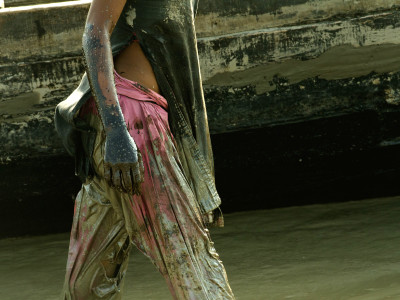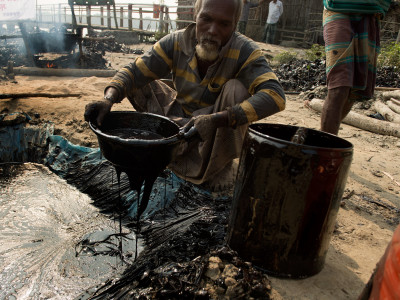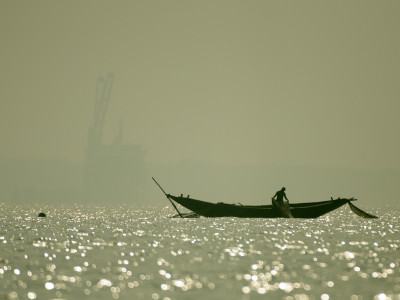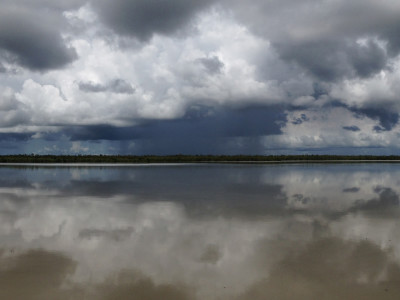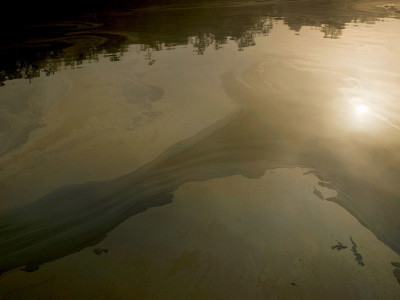Prof. Abdullah Harun Chowdhury was concerned. The oil spill in the Sundarbans was a stone’s throw from sanctuaries for the highly endangered Gangetic and Irrawaddy dolphins, and in an extremely eco-sensitive region. Dipping into his savings, he quickly put together a team of researchers. They packed a traveling lab and equipment onto their research vessel and set off from Khulna University for the Sundarbans.
It was December 11, 2014 — two days after the spill.
They formulated a scientific transect along the way, and decided to spend two weeks taking readings, collecting water, soil, and biological samples every 48 hours, in 15 different contaminated areas and 3 uncontaminated areas (as control). The professor had the advantage of having worked extensively in these areas before. He would know immediately if anything was amiss.
At the end of two weeks, he did not like what he saw.
Water & Soil Contamination


Here is how Prof. Chowdhury interpreted his team’s findings (see his paper, here):
During the periods of study, high oil content, Total Suspended Solids, Chemical Oxygen Demand (COD) and total hardness; low transparency, poor productivity, poor diversity and abundance of phytoplankton and zooplankton, and high content of oil in soil, all indicate that the water and soil of the study areas of the Sundarbans have become polluted.
By International Standards, a maximum of 10 mg /l oil contamination is considered the tolerance level of aquatic biodiversity. More than 10 mg/l of oil creates lethal conditions for aquatic life.
The oil content in mg/l was close to 1000 in the study areas.
Only 18 Phytoplankton (Primary producer of food chain) species were recorded in the oil contaminated areas and abundance was very poor (24-67 units/l).
Compare this with the earlier results: 47 Phytoplankton species were recorded in the Sundarbans and abundance was 226 – 456 units/l. The results indicate that phytoplankton diversity and population/ abundance were affected by the oil contamination.
Only 2 zooplankton (Primary consumer of food chain) species were recorded in the oil contaminated areas and abundance was very poor (6-10 units/l) Compare this with earlier results: 8 zooplankton species were recorded in the Sundarbans and abundance was 53 – 77 units/l. The results indicate that zooplankton diversity and population/ abundance were affected by the oil contamination.
Presence of Protozoa (pollution indicator) in oil contaminated areas also supported in the findings.
When I caught up with the professor, he told me that what worried him most in the study was the total absence of certain fish. “The last week of November to the first week of January is the breeding season for Parshe, Khorsula, and Bagda (a shrimp) species.” The eggs, larvae, and fry of these species cannot survive in polluted waters.
Moreover, these species do not breed in captivity. All the seeds for the very lucrative commercial farms are wild caught. A large number of fisherfolk enter the Sundarbans for this reason alone: to harvest the fry.
These fry thrive in the khals (channels) and the intertidal zones – the very areas that were running black with oil. During his two week transects, neither fish, nor eggs, nor hatchlings were to be found. This finding was borne out empirically, when we encountered many fishermen who all said they could find no fish or shrimp in the waters in the week following the oil spill.
What would that mean for the Sundarbans, which supports hundred of thousands of people and serves as a rich nursery for fish and aquatic life?
The study also threw up a worrying gap in benthic species (an important food source for fish). The team had found only seven species in the oil-contaminated areas, where the norm would have been about 34 species.
After the intensive two week criss-cross of the Sundarbans, the professor concluded that life and productivity had seriously declined in the contaminated areas.
This local study was close to wrapping up when the International UN team arrived to “assess the situation.”
Enter The UN: Weeks Late, Dollars Short
Having made its late entry — two full weeks after the oil spill, the team declared the objective of its mission: “… to strengthen the Government’s efforts in containing and cleaning up the oil spillage, as well as to provide support to assessing the situation and developing an action plan for a phased response and recovery.”
The team worked in the affected area for just four days, from the 23rd to the 27th of December. They went up and down a part of the Sela and Passur rivers for a few hours each day and made observations, took some readings.
Activists and volunteers on the ground wondered, with good reason, what could come of a rapid four day assessment of an oil-spill, two weeks after the disaster.
They also noted one other disturbing development. Days before the international team was to arrive, governmental officials descended on the affected village of Joymoni. They ordered the fishermen to stop burning the oily debris, and to bury every sign of black goo. All the remaining oil was packed into barrels and trucked off to the state-owned company, Padma Oil.
Any tell-tale signs of oil was smothered under sand. Some of the goo was buried inches away from the river.
The officials warned the fisherfolk to say nothing of their illnesses, and to speak nothing of the tons and tons of debris. Word has it that the villagers began denying any health issues and, instead toed the official line: nothing happened here.
The tides were especially high on December 22, 2014 and the waters rushed up the beaches of Joymoni — beaches that were acrid, burning and dark just days prior. To the fresh eyes of the UN team Joymoni looked pristine, prompting a French filming crew to remark, “Why did we come here? There is hardly any oil spill here.”
I spoke to a volunteer who had been helping the villagers at Joymoni. “They have all suddenly gone silent. They are denying even the complaints they made to us a few days ago. They are afraid of the government and the goons,” she said.
“If you come here now, you wont recognize this place.”
Double Speak: Avoid Shipping Traffic Through The Sundarbans Or Not?
The UN published their initial findings in a preliminary report on December 31, 2014. It read like a pat on the back for the Bangladeshi government and offered a mild suggestion to ban traffic through the Sundarbans. As you read through this, cast your mind back to Prof. Chowdhury’s findings.
Based on the mission’s observation, Buy Cheap Tramadol Online Uk there is limited immediate environmental impact to the mangrove and aquatic ecosystems. The comendable (sic) effort by local communities and the Government of Bangladesh, particularly the Forest Department, as well as timely tidal variations and the decision to ban tanker traffic in the river, minimized the penetration of oil into the ecosystem.
The main shorelines 40 km up- and downstream of the site shows varying degree of pollution. https://www.circologhislandi.net/en/conferenze/Purchase tramadol without prescription No visible impact on the mangrove forest floor due to the accident has been observed, and the initial acute impacts to wildlife from this spill appear to be limited in scope. When it comes to impact, the rapid assessment recommends further monitoring to conclusively determine the effect of the residual oil in the aquatic environment and its impacts on fisheries and livelihoods.
…
From an environmental perspective, traffic through the valued and biodiverse Sundarbans World Heritage Site should be avoided. While a number of factors limited the impact of the spill, the shipping of oil through a sensitive environment presents a serious risk to both the environment and the communities that depend on it for their livelihoods – appropriate safeguards and mitigation measures need to be put in place before opening the route to traffic.
This last graf was symptomatic of the toothlessness of the UN mission. The charitable view is that the delayed arrival of the UN team, the duration of its stay, and the extent of coverage of the affected area, combined to render any effort towards the objective ineffective. The fact that the team was always accompanied by government officials may have also influenced what they were shown, where they were taken, and how the local interviewees responded.
Prof. Chowdhury confirmed that the UN experts, in personal conversations, expressed strong reservations against allowing ships through the Sundarbans, and pronounced the impact of the oil-spill as severe. But when the report came out, all such assessments had been softened, parsed through governmental euphemisms, and made to suit business agendas.
Sure enough, the verbiage suited the government well.
On January 7, 2015, less than a month after the oil-spill, the Bangladeshi government re-opened the Sela and Passur rivers to shipping traffic.
The Final UN Report
The final report, published in February, was a lame duck. It hemmed and hawed around the impact of the oil spill, constantly leaning on the crutch of the mission “not having enough time to determine impact,” and straddling the fence by suggesting that the impact “seems limited, but this must not be taken to mean ‘no impact,” and other such dithering.
It had none of the concrete numbers Prof. Chowdhury’s study had — how could it? The team had never gone deep into the khals, nor spent time in the area through high and low tides, spring and neap tides.
This is what they finally concluded from spending 4 days in the area — highlights mine, to stress the areas of departure from Prof. Chowdhury’s study, or departures from on-ground empirical observations from my own trip.
],[https://www.peepli.org/wp-content/uploads/2015/04/UN-finalexcerpt-1000x705.jpg,(large)])
The Dark Legacy
When the government descended on Joymoni and ordered the fisherfolk to bury the oily debris, 35 tons of black gooey toxic mess went underground. It fell upon concerned citizen volunteers to come back to Joymoni and exhort the villagers to reveal the places where they had buried the mess. The volunteers then dug out the toxic debris, and constructed bamboo shelters to store the mess above ground till it could be safely disposed of.
Finding a place to incinerate it was an exercise from hell, according to the volunteers. No brick field wanted to shoulder the responsibility of the toxic mess, and burning it in the open was an absolute no-no given the proximity to eco-sensitive areas and residential areas.
The 35 tons of oily mess lay there for four months before it was finally carted away. Even then, the final solution was far from optimum. The ideal method of disposal would have been to incinerate it, but no such facility could be found. The volunteers finally decided to burn it in a far-away brick kiln – and thus, yet another community in southwestern Bangladesh bore the burden of inhaling highly toxic sulphuric fumes.
Meanwhile in the Sundarbans, ships still chug through her precious waters. If you look closely at the shore, you will see a dark stripe – the residual legacy of a folly, and a warning of a nightmare that is far from over.



